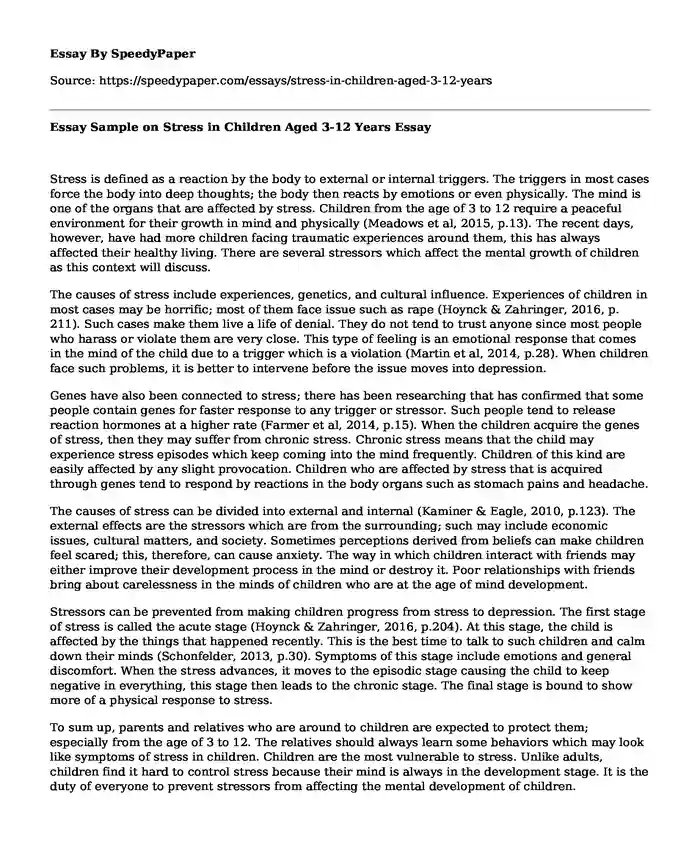
| Type of paper: | Essay |
| Categories: | Child development Stress Mental health Childhood |
| Pages: | 3 |
| Wordcount: | 760 words |
Stress is defined as a reaction by the body to external or internal triggers. The triggers in most cases force the body into deep thoughts; the body then reacts by emotions or even physically. The mind is one of the organs that are affected by stress. Children from the age of 3 to 12 require a peaceful environment for their growth in mind and physically (Meadows et al, 2015, p.13). The recent days, however, have had more children facing traumatic experiences around them, this has always affected their healthy living. There are several stressors which affect the mental growth of children as this context will discuss.
The causes of stress include experiences, genetics, and cultural influence. Experiences of children in most cases may be horrific; most of them face issue such as rape (Hoynck & Zahringer, 2016, p. 211). Such cases make them live a life of denial. They do not tend to trust anyone since most people who harass or violate them are very close. This type of feeling is an emotional response that comes in the mind of the child due to a trigger which is a violation (Martin et al, 2014, p.28). When children face such problems, it is better to intervene before the issue moves into depression.
Genes have also been connected to stress; there has been researching that has confirmed that some people contain genes for faster response to any trigger or stressor. Such people tend to release reaction hormones at a higher rate (Farmer et al, 2014, p.15). When the children acquire the genes of stress, then they may suffer from chronic stress. Chronic stress means that the child may experience stress episodes which keep coming into the mind frequently. Children of this kind are easily affected by any slight provocation. Children who are affected by stress that is acquired through genes tend to respond by reactions in the body organs such as stomach pains and headache.
The causes of stress can be divided into external and internal (Kaminer & Eagle, 2010, p.123). The external effects are the stressors which are from the surrounding; such may include economic issues, cultural matters, and society. Sometimes perceptions derived from beliefs can make children feel scared; this, therefore, can cause anxiety. The way in which children interact with friends may either improve their development process in the mind or destroy it. Poor relationships with friends bring about carelessness in the minds of children who are at the age of mind development.
Stressors can be prevented from making children progress from stress to depression. The first stage of stress is called the acute stage (Hoynck & Zahringer, 2016, p.204). At this stage, the child is affected by the things that happened recently. This is the best time to talk to such children and calm down their minds (Schonfelder, 2013, p.30). Symptoms of this stage include emotions and general discomfort. When the stress advances, it moves to the episodic stage causing the child to keep negative in everything, this stage then leads to the chronic stage. The final stage is bound to show more of a physical response to stress.
To sum up, parents and relatives who are around to children are expected to protect them; especially from the age of 3 to 12. The relatives should always learn some behaviors which may look like symptoms of stress in children. Children are the most vulnerable to stress. Unlike adults, children find it hard to control stress because their mind is always in the development stage. It is the duty of everyone to prevent stressors from affecting the mental development of children.
References
Farmer, C., Vaughan, C., Garnett, J., & Weinick, R. (2014). Methods. In Pre-Deployment Stress, Mental Health, and Help-Seeking Behaviors Among Marines (pp. 13-18). RAND Corporation.
Hoynck, T., & Zahringer, U. (2016). Homicide of Children. In Baier D. & Pfeiffer C. (Eds.), Representative Studies on Victimisation: Research Findings from Germany (pp. 203-230). Baden-Baden, Germany: Nomos Verlagsgesellschaft mbH.
Kaminer, D., & Eagle, G. (2010). TRAUMA AND CHILDREN. In Traumatic Stress in South Africa (pp. 122-145). Johannesburg, South Africa: Wits University Press.
Martin, L., Sontag-Padilla, L., Cannon, J., Chandra, A., Auger, A., Kase, C., Spurlock, K. (2014). SOCIAL AND EMOTIONAL DEVELOPMENT In the Home. In Off to a Good Start: Social and Emotional Development of Memphis' Children (pp. 25-32). Santa Monica, Calif.: RAND Corporation.
Meadows, S., Miller, L., & Robson, S. (2015). Understanding Resilience. In Airman and Family Resilience: Lessons from the Scientific Literature (pp. 9-22). RAND Corporation.
Schonfelder, C. (2013). Theorizing Trauma: Romantic and Postmodern Perspectives on Mental Wounds. In Wounds and Words: Childhood and Family Trauma in Romantic and Postmodern Fiction (pp. 27-86). Bielefeld: Transcript Verlag.
Cite this page
Essay Sample on Stress in Children Aged 3-12 Years. (2023, Jan 09). Retrieved from https://speedypaper.net/essays/stress-in-children-aged-3-12-years
Request Removal
If you are the original author of this essay and no longer wish to have it published on the SpeedyPaper website, please click below to request its removal:
- Free Essay on Gandhi and His Selected Political Writings
- My Writing Process Essay Example
- Ignite-Style Expertise Speech Example on the French Horn
- Essay Example on Orange County Convention Center
- Free Essay on How the American Revolution Changed the American Society
- Free Essay Example on Policing Models
- Essay Sample on The Application of Parse's Theory
Popular categories




